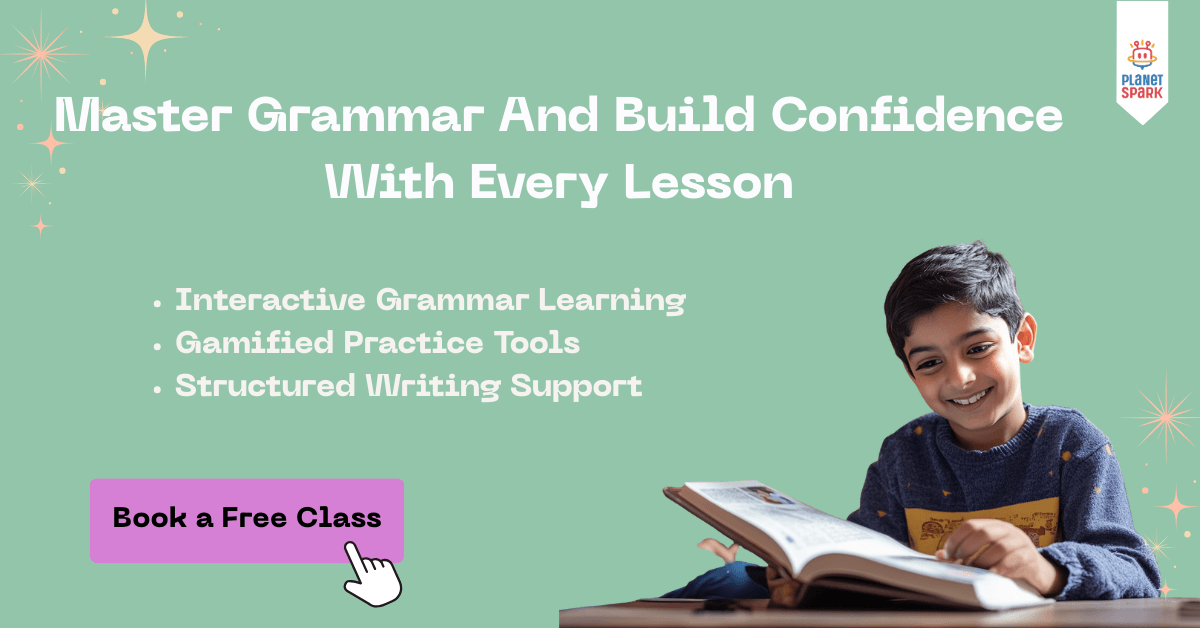Articles for Class 6 – Rules, Examples, & Worksheets for Practice

Articles for Class 6 are often introduced formally at this stage, and students begin to recognize how these words connect nouns to the context of a sentence. For example, the difference between “a cat” and “the cat” may seem subtle, but it carries significant meaning in English. These small words help indicate whether we are talking about something in general or something specific, and this distinction is vital for effective communication.
To support learning, students can practice with an articles worksheet for class 6. These worksheets offer hands-on exercises that reinforce theoretical knowledge, helping students recognize patterns, correct mistakes, and gradually gain confidence in using articles. By combining classroom learning with practical worksheets, students develop a deeper understanding of articles and their importance in the English language.
What Are Articles?
Articles are small but powerful words in English grammar. They are used to define nouns and provide information about whether the noun is specific or general. In simple terms, articles are the words “a,” “an,” and “the,” and they help sentences make sense by showing clarity and context.
In the context of articles for class 6, these words are introduced carefully so that students can grasp both their usage and importance. An article precedes a noun to indicate whether we are talking about a single item, a particular item, or something more general. For instance, “I saw a dog in the park” introduces the dog as any dog, while “I saw the dog in the park” refers to a specific dog already known to the speaker and listener. Understanding this distinction is a crucial part of English grammar for class 6 students.
The purpose of teaching articles for class 6 is to help students lay the groundwork for advanced grammar concepts. When students understand articles, they also learn to recognize singular and plural nouns, countable and uncountable nouns, and how context affects meaning. Articles are among the first tools students use to construct meaningful sentences, making them foundational in grammar learning.
For effective learning, using an article worksheet for class 6 is highly recommended. Worksheets provide exercises that allow students to practice article placement in various sentences, recognise common errors, and apply rules in different contexts. By practicing through worksheets, students gain confidence, reinforce their understanding, and develop the habit of using articles correctly in both writing and speech.
Give Your Child a Head Start in English Grammar
Schedule a free demo session now.
Types of Articles for Class 6
Articles in English are divided into two main types: indefinite articles and the definite article. Understanding these types is essential for mastering articles for class 6 and forming correct sentences.
Indefinite Articles (a, an)
Indefinite articles are used when we are talking about a general noun rather than a specific one. The words “a” and “an” fall under this category. “A” is used before words that start with a consonant sound, while “an” is used before words that start with a vowel sound.
For example:
I saw a cat in the garden. (any cat, not a specific one)
She wants to eat an apple. (any apple, not a specific one)
Indefinite articles are common in everyday writing and speaking, and learning their proper use is a key part of articles for class 6 lessons. They teach students how to introduce new information in a sentence without referring to something already known, which is a skill necessary for effective communication.
Definite Article (the)
The definite article “the” is used when we are talking about something specific or already known to the speaker and listener. It indicates that the noun is unique, familiar, or already mentioned.
For example:
I saw the cat in the garden. (a specific cat, already known)
He went to the library to borrow a book. (a particular library known to both)
Understanding the correct use of “the” helps students avoid vague or confusing sentences. Using the definite article correctly is essential in both formal and informal writing, and it ensures clarity in communication, which is why articles for class 6 focuses extensively on this rule.
Rules for Using Articles for Class 6
Understanding the rules for using articles is essential for students to write grammatically correct sentences. When learning articles for class 6, it is important to know how articles interact with different types of nouns and special cases.
1. Singular vs Plural Nouns
Articles are mainly used with singular nouns.
“A” and “an” are only used with singular nouns:
I saw a bird in the garden.
She wants to eat an orange.
“The” can be used with singular and plural nouns:
I saw the birds flying in the sky.
We read the books you recommended.
By practicing these rules in an articles worksheet for class 6, students can learn to distinguish when to use singular and plural forms correctly with articles, avoiding common mistakes.
2. Countable vs Uncountable Nouns
Countable nouns are those that can be counted individually, e.g., apple, book, dog.
Correct: I bought an apple.
Correct: I saw a dog running in the park.
Uncountable nouns cannot be counted individually, e.g., water, sugar, milk.
Correct: She drinks the water from this bottle.
Incorrect: She drinks a water.
Using examples from articles for class 6, students can clearly see the difference between countable and uncountable nouns. Exercises in an articles worksheet for class 6 help reinforce this understanding.
3. Special Cases (Proper Nouns, General Rules)
Proper nouns usually do not require an article:
Correct: I visited India last year.
Incorrect: I visited the India last year.
Use “the” with certain proper nouns like rivers, seas, mountains, and landmarks:
I climbed the Himalayas.
She swam in the Pacific Ocean.
Articles worksheet for class 6 often includes exercises on these special cases, allowing students to practice and internalize the rules.
Master Articles for Class 6 with Ease!
Book a free demo today and get guided lessons plus the articles worksheet for class 6 for hands-on practice.
Common Mistakes in Articles
Even after learning the rules, students often make mistakes in using articles. Awareness of these mistakes is key to improving grammar skills for articles for class 6.
1. Skipping Articles
Many students omit articles where they are necessary:
Incorrect: I saw cat on the roof.
Correct: I saw a cat on the roof.
Using an articles worksheet for class 6 helps students recognize where articles are missing and correct them.
2. Using Wrong Articles
Choosing the wrong article can change the meaning of a sentence:
Incorrect: She wants a sun for her project.
Correct: She wants the sun for her project.
Exercises in an articles worksheet for class 6 allow learners to practice distinguishing between a, an, and the in different contexts.
3. Confusing Articles with Demonstratives (this/that)
Students sometimes confuse articles with demonstratives like “this,” “that,” “these,” and “those”:
Incorrect: I saw a dog running fast. (referring to a specific dog already mentioned)
Correct: I saw that dog running fast.
Regular practice with an articles worksheet for class 6 can help students avoid this confusion and use articles correctly in both speaking and writing.
Tips for Class 6 Students
Read simple English texts and notice how articles are used.
Write short paragraphs and check if articles are correctly placed.
Complete exercises in articles worksheet for class 6 to reinforce learning.
Review mistakes carefully and practice similar examples until usage becomes natural.
By following these tips and practicing regularly, students can master articles effectively, which improves both their written and spoken English skills.

About PlanetSpark
PlanetSpark is an innovative online learning platform that focuses on helping children improve their English fluency, comprehension, and writing skills in an engaging and interactive way. For students learning articles for class 6, PlanetSpark provides structured lessons, personalized guidance, and practical exercises to strengthen grammar concepts.
Why PlanetSpark is Ideal for Class 6 Students
Personalized Learning: Lessons are tailored to each student’s level, ensuring they master concepts like articles for class 6 at their own pace.
Interactive Online Classes: Experienced educators teach grammar topics, vocabulary, and writing in a fun and easy-to-understand format.
Practical Worksheets: Students can practice rules and examples using resources like the articles worksheet for class 6, helping them gain hands-on experience.
Skill Development: PlanetSpark focuses not only on grammar but also on improving reading comprehension, sentence formation, and creative expression.
Flexible Learning: Online sessions allow students to learn from home, revisit lessons, and practice exercises at any time.
Regular Feedback: Teachers provide guidance and feedback, helping students correct mistakes and strengthen their understanding of concepts like articles for class 6.
Conclusion
Mastering articles for class 6 is an essential step for students to strengthen their English grammar, improve writing clarity, and communicate more effectively. From understanding the difference between a, an, and the to applying rules with singular, plural, countable, and uncountable nouns, students gain confidence in forming accurate and meaningful sentences.
Practical exercises, examples, and worksheets play a vital role in reinforcing these concepts. Using an articles worksheet for class 6, students can practice sentence construction, correct common mistakes, and gradually internalize the proper usage of articles.
Readers Also Read
For students looking to strengthen their grammar skills beyond articles, check out these related resources:
Punctuation for Class 6 – Learn how to use punctuation marks correctly to enhance your writing.
Prepositions for Class 6 – Understand prepositions and practice their usage in sentences.
These topics complement articles for class 6 and can be practiced alongside exercises in the articles worksheet for class 6 to improve overall grammar and writing skills.
FAQs on Articles for Class 6
1. What are articles in English?
Articles are small words, a, an, and the, used to define nouns and indicate whether they are general or specific. They are a key part of articles for class 6 lessons.
2. How do I know when to use “a” or “an”?
Use “a” before words starting with a consonant sound and “an” before words starting with a vowel sound. Practice with an articles worksheet for class 6 to get it right.
3. When should I use “the”?
Use “the” when referring to something specific or already mentioned. Worksheets for articles for class 6 often include examples to help you practice.
4. Are articles important for exams?
Yes. Correct usage of articles affects grammar, writing, and reading comprehension scores. Practicing with an articles worksheet for class 6 can help improve accuracy.
5. Where can I practice articles online?
Students can practice online through platforms like PlanetSpark, which offers interactive lessons and downloadable articles worksheet for class 6 for hands-on learning.
6. What are common mistakes in using articles?
Common errors include skipping articles, using the wrong article, and confusing articles with demonstratives like “this” or “that.” Regular exercises in an articles worksheet for class 6 can help avoid these mistakes.
7. How can I master articles quickly?
Read English texts carefully, write short paragraphs, and complete exercises from the articles worksheet for class 6 to reinforce your understanding.
Personalized Communication Report
Record a video to get a AI generated personalized communication report for your child

Hi There, want to try these
tips for your child with
LIVE with our expert coach?
Let's check your child's
English fluency
